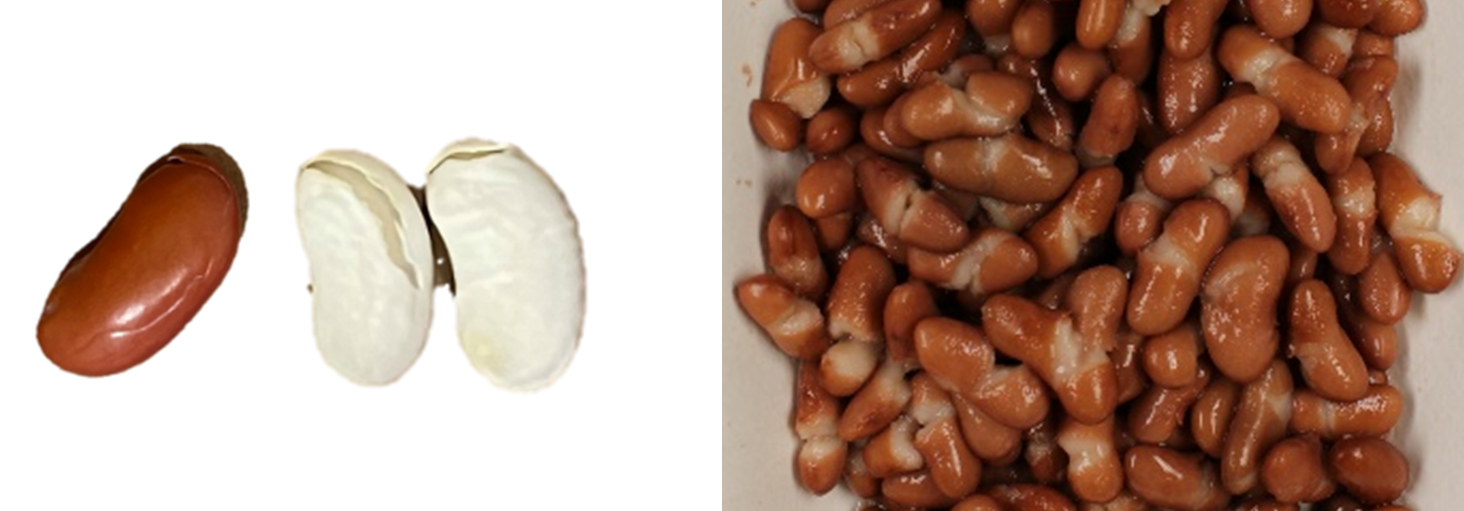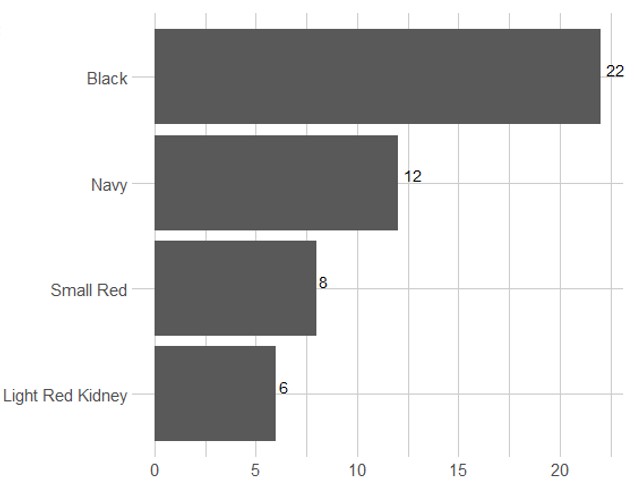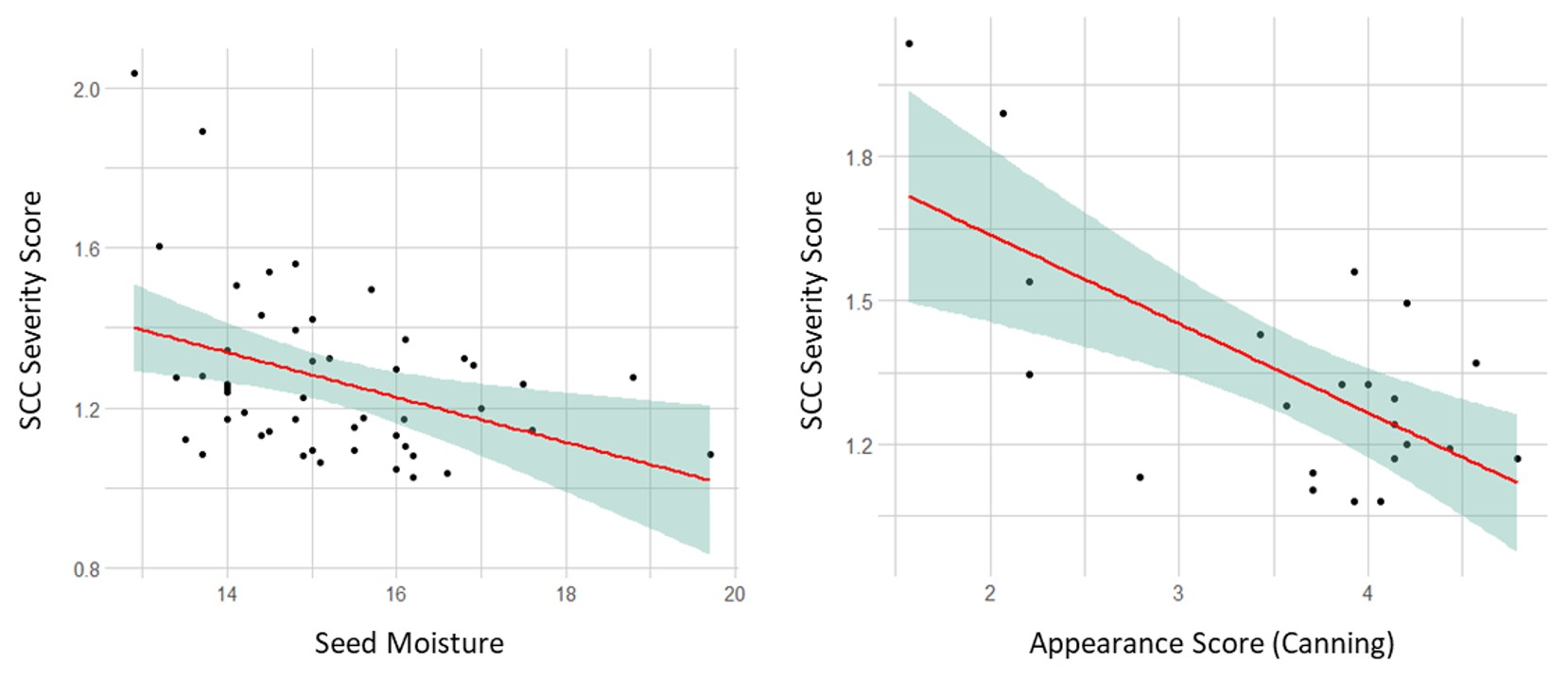Mechanical seed coat damage in dry beans and its effect on end-use product quality
Useful information for dry bean growers and processors to better understand mechanical seed coat damages and ways to prevent it.

With the use of modern equipment in harvest and post-harvest handling of dry beans, the seed coat of beans can be damaged. The damage can result in mild to severe seed coat checks (SCC) and cause split seeds in cooked beans, therefore affecting the quality of end-use products such as canned bean products (Figure 1).

The most significant mechanical seed coat damages usually happen during harvest and warehouse cleaning and handling. While a series of post-harvest cleaning methods are used to remove debris and contaminants, it is difficult to separate and remove seeds with SCC. SCC has been a major seed quality concern for commercial bean growers in both organic and conventional systems and it can cause direct economic consequences. According to a personal conversation with the grower relations manager at ADM seed company in Michigan, at the local elevators, over 10% of checked seeds in a dry sample—or over 20% in a soaked sample—is considered unacceptable and a lower price or discount may be provided or even the entire load may get rejected depending on the general seed quality when they arrive.
Harvest survey identified variations in SCC severity level in Michigan dry beans
A survey was conducted during the 2021 growing season to investigate the mechanical seed coat damage occurring in Michigan-grown dry beans during harvest. A total of 48 Michigan bean growers participated in the survey. The collected samples were tested for seed coat check severity and evaluated for canning quality at Michigan State University (MSU) and U.S. Department of Agriculture (USDA) Agriculture Research Service (ARS) facilities. The number of bean samples collected in each market class in this survey is shown in Figure 2.

The varieties of collected black beans included “Black Beard”, “Specter”, “Zenith”, “Zorro” and “Nimbus”. The varieties of navy beans included “Medalist”, “Bounty” and “Merlin”. The small red beans were all “Viper”. The light red kidney beans included “California Early”, “Big Red” and “Pink Panther”. The agronomic information of the collected samples is summarized in Table 1 below.
|
Table 1. Summary of days to harvest, usage of harvest methods, header type, usage of harvest aid, and seed moisture at harvest of four seed types collected in this study. |
|||||
|
|
Black |
Navy |
Small Red |
Light Red Kidney |
|
|
Days (Planting to Harvest) |
93-114 |
92-117 |
92-102 |
92-108 |
|
|
Harvest Method |
Direct Harvest |
100% |
92% |
88% |
|
|
Windrowed |
|
8% |
13% |
100% |
|
|
Header Type (Direct Harvest Only) |
Auger Head |
55% |
73% |
43% |
|
|
Draper Head |
45% |
27% |
57% |
|
|
|
Harvest Aid |
100% |
92% |
83% |
83% |
|
|
Seed Moisture at Harvest |
12.9-17% |
13.2-18.8% |
13.4-16% |
15-19.7% |
|
A staining test (Figure 3) was used to measure the SCC of collected samples, in which seeds were soaked and then sorted into five groups. An SCC severity score was calculated accordingly to indicate the severity level of seed coat checks. SCC severity score can range from 1-5 (1 = all seeds have no seed coat damage, 5 = all seeds split). SCC percentage (%) was also calculated to indicate the number of seeds with seed coat checks in every 100 seeds.

Variation was identified in the collected bean samples for the severity level of SCC (Table 2). The black bean samples had the biggest range of SCC severity scores (1.08 - 2.04) and SCC percentage (4.5% - 51%), and there were nine out of 22 black bean samples that had a higher than 20% SCC, which is considered unacceptable in the industry standard.
|
Table 2. SCC severity score and SCC percentage in each market class. |
||
|
Market Class |
SCC severity score* |
SCC percentage |
|
Black |
1.08 - 2.04 |
4.5 - 51% |
|
Navy |
1.03 - 1.61 |
1.0 - 30.5% |
|
Small Red |
1.05 - 1.51 |
3.0 - 22% |
|
Light Red Kidney |
1.09 - 1.42 |
6.5 - 33% |
SCC severity score (1 -5): 1 = no seed coat check and 5 = all seeds split.
Factors affect SCC and canning quality
Seed moisture
It was found that seed moisture content at harvest had a significant negative correlation (r= -0.39, P<0.01) with the SCC severity score among all the samples. The seeds with higher seed moisture at harvest tended to have less seed coat damage (lower SCC severity score) being observed in the staining test (Figure 4). A significant negative correlation (r= -0.66, p= <0.001) was found between the SCC severity score and appearance score in black bean samples. It indicates that the less seed coat damages the seeds had at harvest, the better they will appear in canned products. But this correlation was not identified in other seed types, probably because of the limited number of samples we were able to collect.

Harvest methods
When the samples were grouped by harvest methods (auger head combine, draper head combine, or windrowed harvest), there was no statistically significant difference among the harvest methods for SCC severity score. There were two black bean samples harvested by auger head combine that had the highest SCC severity score and were indicated as outliers in the boxplot. But these two samples also had the lowest moisture content at harvest, being 13.7% and 12.9%. There was no sample in the draper head group that had moisture content lower than 14%. Thus, we cannot conclude that the auger head combine would lead to more seed coat damage according to the data in this study.
Varieties
The SCC severity score and canning quality (appearance and color) scores can vary within the same variety (collected from different farms) in the black bean samples (Table 3). One “Black Beard” sample had the lowest SCC severity score of 1.08 while another had the highest SCC severity score of 2.04. The SCC severity score of “Specter” also ranged from 1.13 – 1.89. Significant differences were also identified in appearance and color scores among the 5 different varieties. The canning quality (appearance and color) of “Black beard” and “Zenith” was significantly better than “Specter”.
|
Table 3. SCC severity score and canning quality scores of the different varieties in black bean samples. |
|||
|
Variety Name |
SCC Severity Score* |
Appearance |
Color |
|
Black Beard |
1.08 - 2.04 |
1.57 - 4.79 |
3.29 - 4.71 |
|
Specter |
1.13 - 1.89 |
2.07 - 2.79 |
1.71 -2.93 |
|
Zenith |
1.11 - 1.19 |
3.71 - 4.43 |
4.21 - 4.43 |
|
Zorro |
1.43 |
3.43 |
2.79 |
|
Nimbus |
1.54 |
2.21 |
1.64 |
SCC severity score (1 -5): 1 = no seed coat check and 5 = all seeds split; Appearance (1-5): 1 = Unacceptable and 5 = Excellent; Color (1-5): 1 = light brown and 5 = dark black.
Conclusions
- Seed moisture is a very important factor affecting seed coat damage at harvest according to our survey results. In this study, a seed moisture content close to the lower end (12%) led to severe seed coat damage while seeds with moisture content at the higher end (18%) had significantly less seed coat damage. Therefore, seed moisture content of 14-18% at harvest is recommended with 16% at delivery being optimal.
- The impact of the machinery operation is another important factor for seed coat damage during harvest. The draper head has a reputation for the reduction of seed coat damage. However, our data do not show a statistically significant difference in SCC severity score between auger head and draper head.
- The canning quality of beans can vary among varieties as well as within the same variety. Samples with lower SCC severity scores received less seed coat damage during harvesting and thus tended to have better appearance scores in canning quality evaluation. When we compared varieties in black beans, a significant difference in canning quality was identified, which indicated that variety choice is important in terms of achieving a better quality of canned bean products.
In general, mechanical seed coat damage is not a result of any single factor, but a series of factors including the genetics of the seeds, the seed moisture content, the environmental condition, and the operation of the combine. Dry beans are highly susceptible to mechanical damage and the seed coat damage may result in not only inferior end-use product quality but also impact germination and field production that leads to economic consequences for growers. Thus, extra care is always needed during the harvest and post-harvest process to maintain the integrity of the seeds. The choice of the right bean variety, the right equipment and timing for harvest, the suitable environment condition, the adjustment of the operation according to the environment, and even the right operators are all important to prevent severe seed coat damage.



 Print
Print Email
Email



